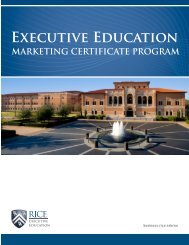Investor Relations and Regulation FD
Investor Relations and Regulation FD
Investor Relations and Regulation FD
You also want an ePaper? Increase the reach of your titles
YUMPU automatically turns print PDFs into web optimized ePapers that Google loves.
most members believed Reg <strong>FD</strong> would have a dramatic effect on their disclosure practices<br />
specifically because of the guidance paragraph which states,<br />
“One common situation that raises special concerns about selective disclosure has been<br />
the practice of securities analysts seeking "guidance" from issuers regarding earnings<br />
forecasts. When an issuer official engages in a private discussion with an analyst who is<br />
seeking guidance about earnings estimates, he or she takes on a high degree of risk under<br />
<strong>Regulation</strong> <strong>FD</strong>. If the issuer official communicates selectively to the analyst nonpublic<br />
information that the company's anticipated earnings will be higher than, lower than, or<br />
even the same as what analysts have been forecasting, the issuer likely will have violated<br />
<strong>Regulation</strong> <strong>FD</strong>. This is true whether the information about earnings is communicated<br />
expressly or through indirect "guidance," the meaning of which is apparent though<br />
implied. Similarly, an issuer cannot render material information immaterial simply by<br />
breaking it into ostensibly non-material pieces.” (Reg <strong>FD</strong>, 2000; Thompson, 2001)<br />
Overall, we believe that firms engaging in professional IR activities were more likely to be<br />
engaged in the activities targeted by the regulation. This paper examines the response of these<br />
firms to Reg <strong>FD</strong> <strong>and</strong> how this change in the economic environment affected them in the years<br />
following the regulation relative to firms without a professional IR function.<br />
Specifically, we focus our analysis on four broad areas suggested by the Reg <strong>FD</strong> <strong>and</strong> IR<br />
literature: disclosure, analyst following, institutional ownership, <strong>and</strong> information asymmetry.<br />
The prior literature largely documents average differences for all firms before <strong>and</strong> after Reg <strong>FD</strong>.<br />
Instead, we focus in the cross-section on a select group of firms engaged in practices specifically<br />
targeted by the regulation. We add to this literature by not only examining the effect of Reg <strong>FD</strong><br />
on a unique subset of relevant firms but also on how firms with professional IR were affected in<br />
the post-Reg <strong>FD</strong> period.<br />
The central theme of Reg <strong>FD</strong> is disclosure – the intention of the rule is to eliminate<br />
private disclosure of nonpublic information to select groups. After Reg <strong>FD</strong>, firms that had been<br />
engaging in private disclosure could either substitute public disclosure for private disclosure or<br />
6
















